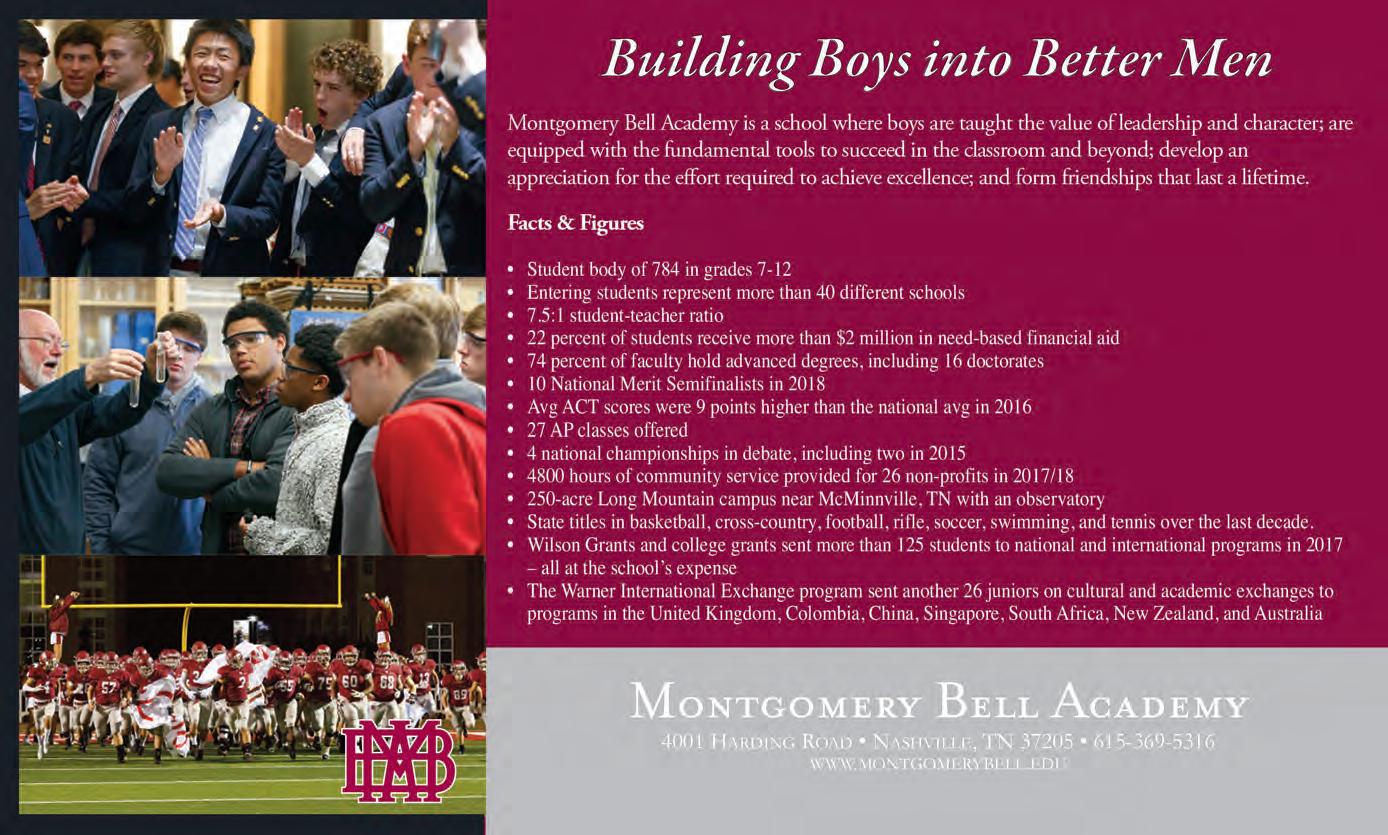
5 minute read
Franklin preserves its historic heart while pushing forward on all fronts
A DUAL IDENTITY BLENDS HISTORY AND OPPORTUNITY AS FRANKLIN THRIVES
BY SUSAN LEATHERS
Advertisement
Historic Franklin has achieved what many small towns across the South only aspire to. The city’s original commercial and residential district, first platted in 1800, has survived war, segregation, urban renewal and economic ups and downs, and is perhaps more popular and beloved than ever. It’s charming. It’s walkable. And there’s nary an empty storefront to be found. The bright art-deco marquee of the c. 1937 Franklin Theater makes a statement on Main Street. Reopened in 2011 after an $8 million restoration, the 300-seat theater is now one of Middle Tennessee’s favorite venues for an intimate concert experience. It also stages community theater productions, hosts community benefits and, yes, even shows a few movies each week. Historic Franklin’s annual street festivals attract hundreds of thousands of people each year. And yet, it’s hard to fathom this small downtown – with many homes and buildings that date back to the 1800s and early 1900s -- is the heart of a city that today almost 72,000 residents call home.
Yet this doesn’t mean downtown Franklin is stuck in the past. Harpeth Square, a $105 million mixed-use project still under construction, is transforming an entire block of downtown Franklin’s northern gateway. Few, though, would have described the largely empty lot it’s replacing as either historic nor charming. And it will bring a much-needed hotel to downtown.
When completed later this year, Harpeth Square will also have 150 apartments and just under 19,000 square feet of retail and office space.
The Heritage Foundation is working to redevelop the campus of O’More College, which has moved to Belmont University in Nashville, into gardens, an entrepreneur center, and events venues (left).
ANDREW COLLIGNON
Harpeth Square spans almost an entire city block with a Hilton Curio Hotel, apartments, and commercial space (right).
CHRISTIE PASSARELLO

Cool Springs brings office towers, retail Just a few miles to the northeast, Cool Springs is as far from historic as you can get. Though a small sliver at its northern border is in neighboring Brentwood, most of this modern commercial and residential area is firmly in Franklin. One of the last farms standing along the Mallory Lane corridor just west of I-65 has given way to Mallory Green, a new mixed-use development going up between Cool Springs Boulevard and McEwen Boulevard.
Directly east and across the Interstate, Nissan North America’s striking, 10-story headquarters stood alone when it opened in 2008. Today the carmaker’s corporate campus is surrounded by high-rise, mixed-use and residential developments in various stages of completion. And a new plan was recently announced for redevelopment around one of the first office complexes in Cool Springs east, built in 1994 for Ford Motor Credit. The East Works District plan envisions replacing 2,000 surface parking spaces around the Carothers Building with retail, residential, office space, hotels and green space.
Old Franklin goes back more than two centuries, to its founding in 1799 as the county seat and its growth as the center of a prosperous farming community dotted with plantations. Its story includes the bloody Battle of Franklin, the ravages of the Civil War and the years of reconstruction and recovery that followed.
New Franklin now stretches south along both sides of the I-65 corridor from Moore’s Lane, past the McEwen Drive and Hwy. 96 interchanges and on south to the quickly populating Berry Farms area.
The dichotomy of the two Franklins can’t be denied.
Transformative nonprofit pushes forward In late February, the Heritage Foundation of Williamson County – the key player in Historic Franklin’s transformation from tired small town to historic tourism hotspot – announced it had raised $6 million in six months and purchased the former O’More College of Design campus, located just three blocks east of Historic Franklin’s Main Street.
In a nod to the past, the foundation plans to restore the property’s historic integrity over the next 18- to 24 months. The campus came with two historic homes, the c. 1866 Abbey Leix mansion and the c. 1887 Fleming-Farrah Hall. Heritage Foundation Executive Director Bari Beasley admits the plans – which include removing modern structures, restoring existing and creating new gardens, adding a 300- seat conservatory and more – are ambitious and come with a hefty, $14 million price tag. “This is a really complex project,” she says, and one that will involve and include many stakeholders, including the City of Franklin. The foundation’s director of preservation, Dr. Blake Wintory, is already hard at work researching the historic homes’ and gardens’ original plans, Beasley says.
The ultimate vision is to create an “estate and gardens” where the public can experience historic preservation, participate in preservation education classes and camps, and enjoy the arts.
In a nod to the future, the campus was renamed Franklin Grove, and will be home to The Idea Center, the county’s first incubation space dedicated to innovation and entrepreneurship. Williamson, Inc., the county’s chamber of commerce and economic development arm, hopes to open The Idea House in Fleming-Farrah Hall this October, leasing the space from the foundation.
The Romanesque Revival style home was remodeled by O’More’s interior design department in 2014. Still there is work to be done to turn the hall, used by the college for classroom and studio space, into The Idea Center. The chamber has already received
a TN Placemakers Entrepreneurship Fund grant from the state and is researching other grant and funding opportunities to take care of the interior renovations.
Several parameters will be used to select the entrepreneurs who can work out of the center for up to three years. The most important will be an enterprise’s scalability and ability to grow out of the space in a short amount of time, according to Elizabeth McCreary, the chamber’s chief economic development officer.
Small businesses are a key Entrepreneurs and small business owners are key to the county’s economy. Of the 6,821 Williamson County Businesses, 3,551 (or 52%) of them have one to four employees. In fact, despite all of the shiny, high-rise office buildings in Cool Springs, only 200 businesses in Williamson County have 100 or more employees, according to Williamson, Inc. data.
Though it may sometimes seem as though there’s a disconnect between old and new Franklin, the Heritage Foundation and Williamson, Inc. agree that historic preservation is a valuable commodity that drives economic vitality.
“I have really appreciated how Williamson, Inc. has included the Heritage Foundation in its recruitment process,” when enticing new companies to relocate in Franklin and Williamson County, says Beasley, who also serves on the Williamson, Inc. board. “They always include visits to downtown Franklin. We love that.
“We are one of the pieces of the puzzle that helps drive people to Williamson County.”

The Franklin Farmers Market shed is behind The Factory at Franklin and is open during harvest season.
STEVE HARMAN











